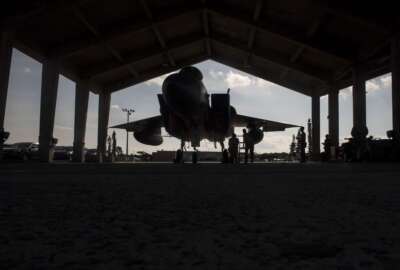
Exclusive
New Air Force installations strategy plans for sustained budget increases and demolished buildings
The Air Force is paying more attention to its installations, as the deferred maintenance bill gets higher.
Best listening experience is on Chrome, Firefox or Safari. Subscribe to Federal Drive’s daily audio interviews on Apple Podcasts or PodcastOne.
As the Air Force struggles with $33 billion in deferred maintenance in its 180 installations worldwide, the service is implementing a new investment strategy to move to a fiscally-sustainable and right-sized infrastructure.
The strategy, released Monday, hopes to tackle a maintenance deficit that is expected to triple over the next 30 years by planning small, sustained budget growth paired with the use of big data techniques and offloading troublesome and expensive facilities.
“What this installations investment strategy does is have us look at what we need to do to ensure these installations are capable now and 20 years into the future,” Richard Hartley, Air Force principal deputy assistant secretary for installations, environment and energy, told Federal News Network.
The Air Force addresses both readiness and operational capability by prioritizing the maintenance of installations for mission critical needs, modernizing facilities more effectively and using better methods to track the best times to fix or upgrade infrastructure.
The hope is to turn the tides of Air Force facilities and installations, which have eroded over the past 20 years as the service and the military as a whole prioritized other accounts. Installations are now hitting a breaking point where further deferment will “ultimately disrupt combat readiness and lethality,” the strategy states.
“In situations where the backlog grows you’ll have impacts on everything across the spectrum of airman quality of life to issues that could affect readiness,” Hartley said. “You might have problems with the runway, so instead of being able to takeoff and launch without any fear of risk, you might have to do a walk every morning to check the runway to make sure there aren’t any pieces coming up from the runway.”
Hartley said the most important part of the strategy is the sustained funding increase at a minimum of 2 percent each year. That number is on the lower side of most industry investments in their infrastructure, which usually runs about 2 percent to 4 percent. Hartley said 2 percent for the Air Force translates to about a billion dollar increase per year.
The 2020 budget request asked for about $4.82 billion in the facilities sustainment, restoration and modernization account for the total Air Force, about $1.5 billion more than what was appropriated last year.
“A key component of this strategy is sufficient and stable funding,” Hartley said. “We are asking for an increase from what we’ve spent over the past few years, and that is a 2 percent floor we are going to try to put in place in the budget. That essentially gets us more money than we had in the recent past, and I would say that’s critical seed money to make this strategy successful. If we can’t secure enough funding to initiate this effort we will still be in the situation where we can’t change the proverbial oil. If we can’t change the oil; we are going to be in a situation where we are forced to change the engines that break.”
The extra funds will go into identifying areas where the Air Force can restore facilities by hardening infrastructure and converting to more resilient energy sources to reduce vulnerabilities and recover faster. The Air Force plans to get its infrastructure to a 90 percent mission capability rate or higher for critical infrastructure.
While the strategy calls for more investment, it also plans to make Air Force infrastructure more efficient.
The strategy will develop installation master plans to align requirements and investments with the National Defense Strategy. Ultimately, the goal is to reduce total facility square footage by 5 percent in 20 years through divestment, demolition, conversion and consolidation.
The Air Force also plans to save money in the way it modernizes. It plans to develop and adopt standard designs and criteria to reduce planning design and construction cost.
It will also use analytics to decide when it is best to modernize a building before it becomes more cost savvy to just tear down the building and start from scratch.
As part of the strategy, the Air Force will also continue its investment in new technologies that analyze big data. New sensors installed in buildings can better predict when maintenance is needed before a system breaks or fails.
Additionally, the service will use better acquisition tools like buying in larger volumes for cheaper prices to drive costs down.
Copyright © 2024 Federal News Network. All rights reserved. This website is not intended for users located within the European Economic Area.
Scott Maucione is a defense reporter for Federal News Network and reports on human capital, workforce and the Defense Department at-large.
Follow @smaucioneWFED
Related Stories





